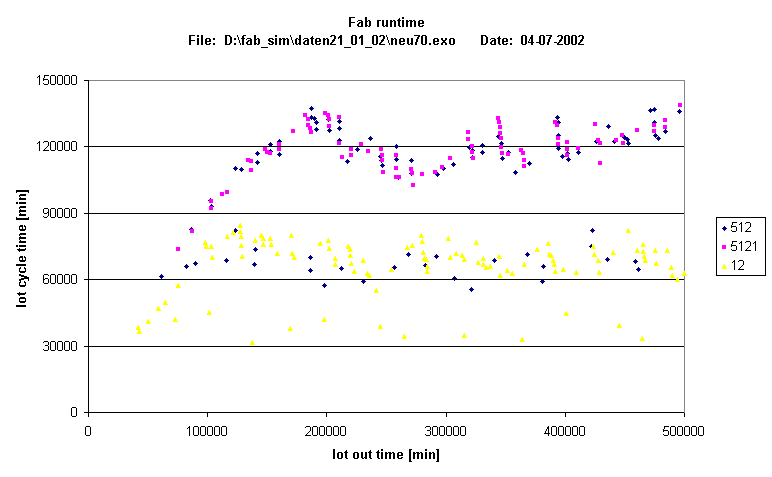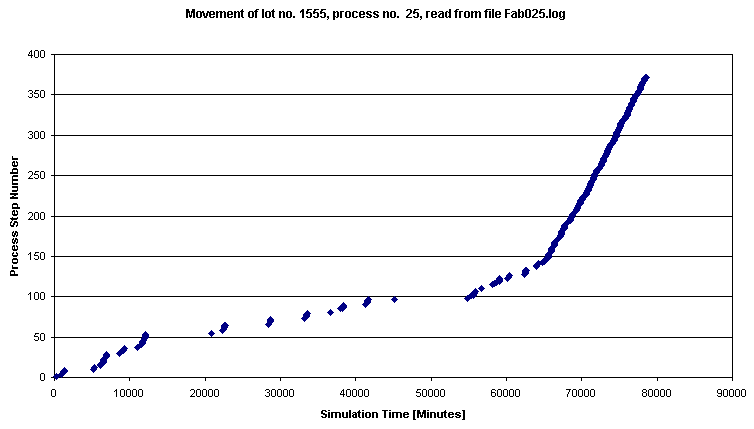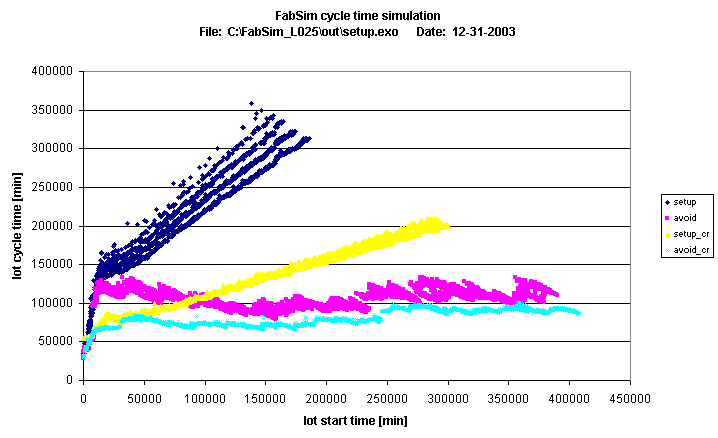Home
Factory simulation
About FabSim
Simulation results
Interactive simulation
User Interfaces
Mini-fab example
Downloads
News
Interesting links
Contact
Wip 300 Wip 900 Hot lots Process mix Cycle time Change lot priority Setup avoidance and dispatch
The simulation results shown below describe a semiconductor fab with 500 wafer starts per day. There are 48 groups of toolsets with up to 15 tools per set, serving a complex five metal level, dual gate oxide 0.25 Ám process flow with 370 steps. A typical simulation time is 3 minutes on a 1.4 GHz Athlon per year real time.
If you run the fab with a fixed wip of 300 lots, you will stay slightly below the planned capacity. The run time for each lot coming out of the fab is plotted in the first pictures versus the time the lot leaves the fab. A mean run time of 28,200 minutes is calculated after stabilisation.
Raising the wip to 900 wafers will result in an mean run time of 66,000 minutes as shown in the next picture. The theoretical minimum run time is still around 18,000 minutes. There is some "ringing" during the startup of the fab due to the simple control strategy (Start a new lot only when the wip falls below the given limit). So the relevant data of a stable fab under this condition may be extracted only after the first 300,000 minutes have passed.
The influence of introducing "hot lots" is demonstrated in the next picture. Around 5% "super hot lots" are started among the 95% normal lots. "Super hot lot" defines a lot with top level priority. These lots always move to the front of any queue at each tool set entrance. In addition machines to be loaded next with this lot will wait, even if lower priority lots are there. If no other lot is available in the queue, the super hot lot will be started even if there is a rule for a minimum batch size. Every 80 minutes a lot is started.
The hot lots consistently run with small deviation and 25,600 minutes, the run time of all other lots increases from 33,000 to 50,300 minutes.
Three processes, two of them (512 and 12) with some additional super hot lots, run through a pilot line. The influence of a process mix may be studied by varying the ratio of lots during start.

Cycle time versus WIP is shown next for a large fab. Each data point is from a 1 year simulation (3 minutes on a PC) by keeping WIP constant. Data are taken after the fab has stabilized (mean value during the final 140 days).
The next graph demonstrates the increase of lot priority on lot cycle time. The whole simulation and evaluation takes 3 minutes of your real time. This was the procedure: Start FabSim Interactive, load lots from LotStatus.log (recorded during a previous simulation of a stable fab), start a new lot manually, run for 5 minutes, record new lot number (1555), set halt of this lot at 150 steps (total amount of steps would be 373), raise lot priority at next halt, continue simulation for another 50000 minutes, evaluate and plot ouput from Fab025.log with EVAL_Lot.xls.

You may compare the cycle time behaviour as function of setup and dispatching rules. In the following example the lot start rate remains unchanged (500 lots are started quickly, then every 80 minutes a lot is released into the fab). Stepper toolsets (i-line and deep UV) and implanters (medium and high current) need setup if mask or implant species change. The graphs setup and setup_cr are calculated under the premise that each lot arriving will initiate an equipment setup if required. Setup_cr sorts the buffers of the 4 toolsets according to a "critical ratio" rule. The graphs avoid and avoid_cr add a strict setup avoidance policy. Equipment setup will only occur if no match between lots and existing setup is found. Setup avoidance dramatically decreases the lot cycle time, critical ratio rule further enhances factory throughput.
